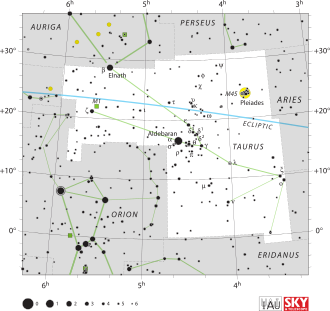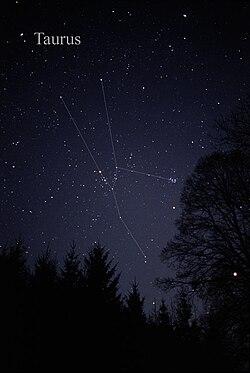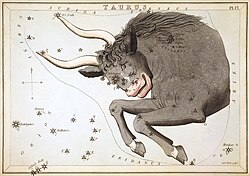Taurus (constellation)
| Constellation | |
 | |
| Abbreviation | Tau[1] |
|---|---|
| Genitive | Tauri[1] |
| Pronunciation | /ˈtɔːrəs/ TOR-əs; genitive 17th) |
| Main stars | 19 |
| Bayer/Flamsteed stars | 132 |
| Stars brighter than 3.00m | 4 |
| Stars within 10.00 pc (32.62 ly) | 1[a] |
| Brightest star | Aldebaran (α Tau) (0.85m) |
| Messier objects | 2 |
| Meteor showers | |
| Bordering constellations | |
| Visible at latitudes between + 65 °.Best visible at 21:00 (9 p.m.) during the month of January. | |
Taurus (Latin, '
(♉︎), which resembles a bull's head.A number of features exist that are of interest to astronomers. Taurus hosts two of the nearest
Characteristics
Taurus is a large and prominent constellation in the
This constellation forms part of the zodiac and hence is intersected by the
The recommended three-letter abbreviation for the constellation, as adopted by the
Features
Stars

There are four stars above magnitude 3 in Taurus.
The brightest member of this constellation is Aldebaran, an orange-hued,
The Hyades span about 5° of the sky, so that they can only be viewed in their entirety with binoculars or the unaided eye.
In the northwestern quadrant of the Taurus constellation lie the Pleiades (M45), one of the best known open clusters, easily visible to the naked eye. The seven most prominent stars in this cluster are at least visual magnitude six, and so the cluster is also named the "Seven Sisters". However, many more stars are visible with even a modest telescope.[21] Astronomers estimate that the cluster has approximately 500–1,000 stars, all of which are around 100 million years old. However, they vary considerably in type. The Pleiades themselves are represented by large, bright stars; also many small brown dwarfs and white dwarfs exist. The cluster is estimated to dissipate in another 250 million years.[22] The Pleiades cluster is classified as a Shapley class c and Trumpler class I 3 r n cluster, indicating that it is irregularly shaped and loose, though concentrated at its center and detached from the star-field.[23]
To the east, the two horns of the bull are formed by
The star

Located about 1.8° west of
| Proper Name | Designation | Light Years | Apparent Magnitude |
|---|---|---|---|
| Aldebaran | α Tauri | 65 | 0.87 |
| Elnath | β Tauri | 131 | 1.65 |
| Alcyone A | η Tauri | 368 | 2.85 |
| Tianguan | ζ Tauri | 417 | 2.97 |
| Chamukuy | θ Tauri | 149 | 3.40 |
| Sadr al Tauri | λ Tauri | 370 | 3.41 |
| Ain | ε Tauri | 155 | 3.53 |
| Omicron Tauri | ο Tauri | 211 | 3.61 |
| Atlas A | 27 Tauri | 380 | 3.62 |
| Prima Hyadum | γ Tauri | 154 | 3.65 |
Deep-sky objects
In the northern part of the constellation to the northeast of the Pleiades lies the Crystal Ball Nebula, known by its catalogue designation of NGC 1514. This planetary nebula is of historical interest following its discovery by German-born English astronomer William Herschel in 1790. Prior to that time, astronomers had assumed that nebulae were simply unresolved groups of stars. However, Herschel could clearly resolve a star at the center of the nebula that was surrounded by a nebulous cloud of some type. In 1864, English astronomer William Huggins used the spectrum of this nebula to deduce that the nebula is a luminous gas, rather than stars.[29]
Identifier |
Mag. |
Object type
|
|---|---|---|
| NGC 1514 | 10.9 | planetary nebula |
| NGC 1647 | 6.4 | open cluster |
| NGC 1746 | 6 | asterism[31] |
| NGC 1817 | 7.7 | open cluster |
NGC 1952 |
8.4 | supernova remnant (M1) |
North-west of ζ Tauri by 1.15 degrees is the Crab Nebula (M1), a supernova remnant. This expanding nebula was created by a Type II supernova explosion, which was seen from Earth on July 4, 1054. It was bright enough to be observed during the day and is mentioned in Chinese historical texts. At its peak, the supernova reached magnitude −4, but the nebula is currently magnitude 8.4 and requires a telescope to observe.[32][33] North American peoples also observed the supernova, as evidenced from a painting on a New Mexican canyon and various pieces of pottery that depict the event. However, the remnant itself was not discovered until 1731, when John Bevis found it.[22]

This constellation includes part of the Taurus-Auriga complex, or Taurus dark clouds, a star-forming region containing sparse, filamentary clouds of gas and dust. This spans a diameter of 98
Meteor showers
During November, the
History and mythology
The identification of the
Taurus marked the point of
In the
The same iconic representation of the Heavenly Bull was depicted in the
In
Taurus became an important object of worship among the Druids. Their Tauric religious festival was held while the Sun passed through the constellation.[41] Among the arctic people known as the Inuit, the constellation is called Sakiattiat and the Hyades is Nanurjuk, with the latter representing the spirit of the polar bear. Aldebaran represents the bear, with the remainder of the stars in the Hyades being dogs that are holding the beast at bay.[53]
In
In 1990, due to the
Astrology
As of 2008[update], the Sun appears in the constellation Taurus from May 13 to June 21.
Space exploration
The
Solar eclipse of May 29, 1919
Several stars in the Hyades star cluster, including
See also
- Pleiades in folklore and literature
- Taurus (Chinese astronomy)
Notes
- ^ This is Gliese 176.
References
- ^ a b c d "The constellations". IAU. Archived from the original on 2009-05-12. Retrieved 2010-02-09.
- ^ "Taurus". Merriam-Webster Online. Retrieved 2010-02-09.
- ^ S2CID 122459258.
- ^ ISBN 978-0-521-59889-7.
- ISBN 978-3-211-00851-5.
- Bibcode:1922PA.....30..469R.
- ^ "Taurus, constellation boundary". The Constellations. International Astronomical Union. Archived from the original on 2013-06-05. Retrieved 2012-01-02.
- ISBN 978-0-495-38724-4.
- ^ "Taurus, the bull". Allthesky.com. Retrieved 2012-05-16.
- ^ OCLC 1028860438.
- ^ Chartrand 1983, p. 188.
- ISBN 978-0-471-70410-2.
- ^ Allen 1963, p. 383.
- )
- ISBN 978-1-85233-709-4.
- ISBN 978-1-4027-0800-8.
- ^ S2CID 56049041.
- ^ Ridpath & Tirion 2003, p. 55.
- ^ a b "Naming Stars". IAU.org. Archived from the original on 11 April 2020. Retrieved 8 August 2018.
- ^ Kaler, James B. "Theta-1 Tauri". Stars. University of Illinois. Retrieved 2012-05-22.
- ISBN 978-0-521-39549-6.
- ^ ISBN 978-1-55407-175-3.
- ^ Levy 2005, p. 94.
- ^ Chartrand 1983, p. 184.
- hdl:2152/34674.
- .
- ^ "T Tauri in NGC 1555". National Optical Astronomy Observatory. Retrieved 2009-08-16.
- ^ O'Meara 2011, p. 475.
- ^ O'Meara 2011, pp. 74–77.
- ISBN 978-1447100713.
- ^ a b O'Meara 2011, p. 84.
- ISBN 978-981-238-123-1.
- ISBN 978-0-521-52419-3.
- ISBN 978-3-540-23711-2.
- ISBN 978-0-412-98391-7.
- ISBN 978-0-201-15494-8.
- ^ a b Jenniskens, Peter (September 2012). "Mapping Meteoroid Orbits: New Meteor Showers Discovered". Sky & Telescope: 22.
- arXiv:0810.1592 [physics.hist-ph].
- ^ Whitehouse, David (August 9, 2000). "Ice age star map discovered". BBC. Retrieved 2009-10-11.
- ISBN 978-1-59558-558-5.
- ^ ISBN 978-0-86690-049-2.
- ^ Bibcode:1998JBAA..108....9R.
- ISBN 978-0-7484-0748-4.
- S2CID 162361349.
- ISBN 978-1-4000-7733-5.
- Bibcode:1986plos.book.....G.
- ISBN 978-0-9559037-0-0.
- Bibcode:1998JBAA..108....9R.
- ISBN 978-1-56072-507-7.
- ^ Allen 1963, p. 381.
- ISBN 978-0718894788.
- ISBN 978-0-86516-320-1.
- ISBN 978-1441968036.
- ^ Grünwedel, Albert (1901). Burgess, James (ed.). Buddhist art in India. Agnes C. Gibson. B. Quaritch. p. 131.
- ]
- OCLC 1751590.
- ISBN 978-1-4292-3042-1.
- ISBN 978-1-57863-298-5.
- ^ Mewhinney, Michael (February 25, 2003), Pioneer 10 Spacecraft Sends Last Signal, NASA, archived from the original on 2012-06-28, retrieved 2015-11-04.
- .
Book references
- Allen, Richard Hinckley (1963) [1899]. Star names: their lore and meaning (corrected ed.). Dover Publications. p. 383. )
- Chartrand, Mark R. (1983). Skyguide: A Field Guide for Amateur Astronomers. Golden Books Publishing Company. ISBN 0-307-13667-1.
- Levy, David H. (2005). Deep Sky Objects. Prometheus Books. ISBN 978-1-59102-361-6.
- O'Meara, Stephen James (2011). Deep-sky companions: the secret deep. Cambridge University Press. ISBN 978-0-521-19876-9.
- Ridpath, Ian; Tirion, Wil (2003). Monthly sky guide (6th ed.). Cambridge University Press. ISBN 978-0-521-53306-5.
- ISBN 978-0-008-23927-5.
External links
- The Deep Photographic Guide to the Constellations: Taurus
- BBC article on the possibility of Taurus being represented in Lascaux
- Star Tales – Taurus
- Warburg Institute Iconographic Database (medieval and early modern images of Taurus)
- The clickable Taurus

